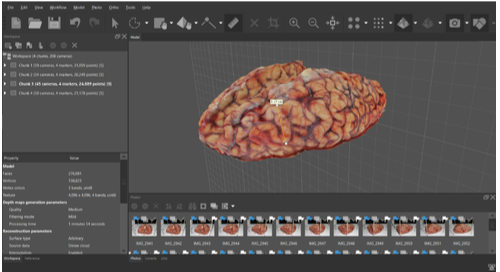Rendering Kinetics and Hardware Relationship for the Digitization of Images of the Neurobank of the University of Antioquia
Cinética de renderizado y relación de hardware para la digitalización de imágenes del Neurobanco de la Universidad de Antioquia


This work is licensed under a Creative Commons Attribution-NonCommercial-NoDerivatives 4.0 International License.
Copyright statement
The authors exclusively assign to the Universidad EIA, with the power to assign to third parties, all the exploitation rights that derive from the works that are accepted for publication in the Revista EIA, as well as in any product derived from it and, in in particular, those of reproduction, distribution, public communication (including interactive making available) and transformation (including adaptation, modification and, where appropriate, translation), for all types of exploitation (by way of example and not limitation : in paper, electronic, online, computer or audiovisual format, as well as in any other format, even for promotional or advertising purposes and / or for the production of derivative products), for a worldwide territorial scope and for the entire duration of the rights provided for in the current published text of the Intellectual Property Law. This assignment will be made by the authors without the right to any type of remuneration or compensation.
Consequently, the author may not publish or disseminate the works that are selected for publication in the Revista EIA, neither totally nor partially, nor authorize their publication to third parties, without the prior express authorization, requested and granted in writing, from the Univeridad EIA.
Show authors biography
Brain cuts in specific anatomical regions are key to the understanding and description of some pathologies related to neurodegenerative diseases, image processing is an emerging area allows the digitalization of information, for the creation of a digital bank from brain, cuts images in the Neurobanco research line of the Neuroscience Group of Antioquia. The software used for image processing was Agisoft © Metashape, with which the three-dimensional rendering of photos is done since it is essential to know the hardware conditions to explore the potential of rendering in the software, for a shorter time, considering concepts of mask_tie point and mask_key point, computational processing units and graphics processing units. The obtained software sets, kinetic calculations and independent and combined graphics processing ratio, determined that the best hardware set from a technical and functional aspect is a desktop computer with the combination of a high power processing unit with high power a video card (Intel-i7 8700 with a GTX 1060 video card). However, regarding an economic relationship, the best hardware is a medium power processing and a medium or high power graphic card (Intel i5 9400 with a GTX 1660 video card), given that this combination gives greater potential in the three-dimensional image processing than hardware with only one processor, even if it is of high power. Finally, as a relevant aspect, it is expected to complement the analysis from the study of set hardware from the Radeon company, which offers alternatives such as AMD Rx 5700XT video cards.
Article visits 563 | PDF visits 316
Downloads
- Beltran, R. S. et al. (2018) ‘An evaluation of three-dimensional photogrammetric and morphometric techniques for estimating volume and mass in Weddell seals Leptonychotes weddellii’, PLoS ONE, 13(1), pp. 1–15. doi: 10.1371/journal.pone.0189865.
- Fathi, H. and Brilakis, I. (2011) ‘Automated sparse 3D point cloud generation of infrastructure using its distinctive visual features’, Advanced Engineering Informatics. Elsevier Ltd, 25(4), pp. 760–770. doi: 10.1016/j.aei.2011.06.001.
- Goodbody, T. R. H., Coops, N. C. and White, J. C. (2019) ‘Digital Aerial Photogrammetry for Updating Area-Based Forest Inventories: A Review of Opportunities, Challenges, and Future Directions’, Current Forestry Reports. Current Forestry Reports, pp. 55–75. doi: 10.1007/s40725-019-00087-2.
- Gray, P. C. et al. (2019) ‘Drones and convolutional neural networks facilitate automated and accurate cetacean species identification and photogrammetry’, Methods in Ecology and Evolution, 10(9), pp. 1490–1500. doi: 10.1111/2041-210X.13246.
- Harris Geospatial Solutions, I. (2020) Collect and Edit Tie Points, L3Harris Geospatial solutions. Available at: https://www.harrisgeospatial.com/docs/CollectingEditingTiePoints.html (Accessed: 11 February 2020).
- Julien, Fauqueur, Nick , Kingsbury and Ryan, A. (2006) ‘Multiscale keypoint detection using the dual-tree complex wavelet tranform’, IEEE Computer Graphics and Applications. doi: 10.1109/ICIP.2006.312656.
- Lai, J. Y. et al. (2018) ‘A high-resolution texture mapping technique for 3D textured model’, Applied Sciences (Switzerland), 8(11). doi: 10.3390/app8112228.
- Lane, S. N., Richards, K. S. and Chandler, J. H. (1993) ‘Developments in photogrammetry; the geomorphological potential’, Progress in Physical Geography, 17(3), pp. 306–328. doi: 10.1177/030913339301700302.
- Levine, J. A., Paulsen, R. R. and Zhang, Y. (2012) ‘Mesh processing in medical-image analysis-a Tutorial’, IEEE Computer Graphics and Applications. IEEE, 32(5), pp. 22–28. doi: 10.1109/MCG.2012.91.
- Mikrut, S., Mikrut, Z. (1992) ‘Neural Networks in the Automation of Photogrammetric’, The international archives of the photogrammetry, remote sensing and spatial information sciences, 1988(4), pp. 331–336.
- Nvidia (1995) GEForces-Gtx serie 10, Nvidia Corporation. Available at: https://www.nvidia.com/es-la/geforce/products/ (Accessed: 11 February 2020).
- R&D work Agisoft LLC (2006) Agisoft-metashape software, Agisoft software solution. Available at: https://www.agisoft.com/ (Accessed: 11 February 2020).
- Radeon (1969) AMD-Radeon Rx-5700 XT, Silicon valley. Available at: https://www.amd.com/es/corporate/about-amd (Accessed: 11 February 2020).
- Schenk, T. (2005) Introduction of Photogrammetry, The Ohio State University. Available at: http://www.mat.uc.pt/~gil/downloads/IntroPhoto.pdf (Accessed: 11 February 2020).
- Song, Z., Mu, X. and Zhou, H. X. (2017) ‘High Performance Computing of Complex Electromagnetic Algorithms Based on GPU/CPU Heterogeneous Platform and Its Applications to em Scattering and Multilayered Medium Structure’, International Journal of Antennas and Propagation, 2017. doi: 10.1155/2017/9173062.
- Su, Hang, Jampani, Varun, Sun, Deqing, Maji, Subhransu, Kalogerakis, evangelos, Yang, Ming Hsuan, Kautz, J. (2018) ‘SPLATNet : Sparse Lattice Networks for Point Cloud Processing’, Proceedings of the IEEE Computer Society Conference on Computer Vision and Pattern Recognition, pp. 2530–2539. Available at: http://openaccess.thecvf.com/content_cvpr_2018/papers/Su_SPLATNet_Sparse_Lattice_CVPR_2018_paper.pdf.
- Teodoro, G. et al. (2017) ‘Application Performance Analysis and Efficient Execution on Systems with multi-core CPUs, GPUs and MICs: A Case Study with Microscopy Image Analysis’, International Journal of High Performance Computing Applications, pp. 1–39. doi: 10.1177/1094342015594519.Application.
- Uchida, S. (2013) ‘Image processing and recognition for biological images’, Development Growth and Differentiation, 55(4), pp. 523–549. doi: 10.1111/dgd.12054.




